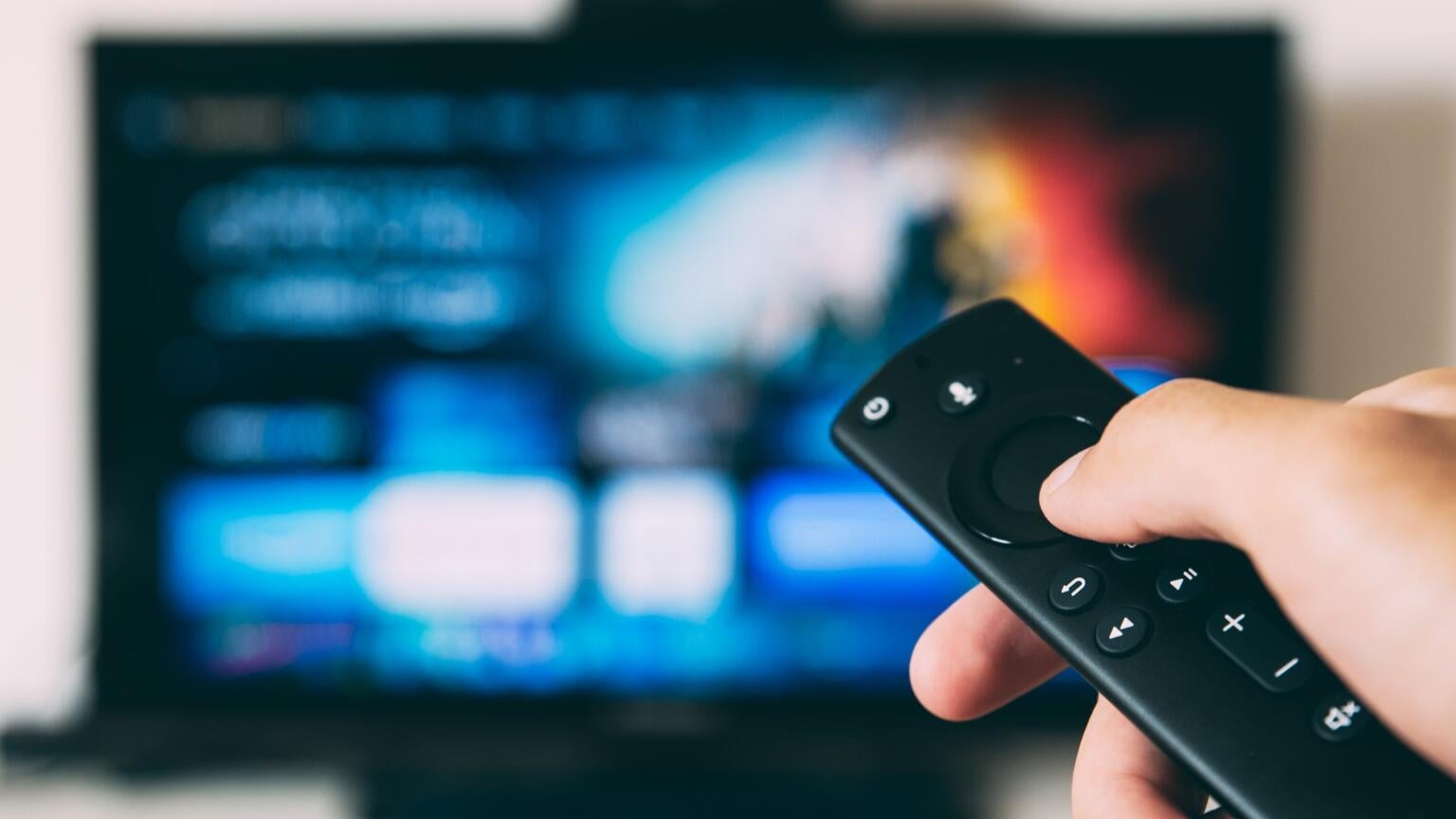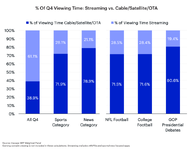Cable Sees More Customers ‘Quiet Quitting’; Streaming App Usage Leveling Off Even as Streaming Time Rises
A new report from Inscape shows that streaming providers might want to get more comfortable with bundling, or risk ending up on the scrap heap.

Even as broadcast executives continue to profess their faith in traditional TV, confronting hard numbers about the decline of cable and satellite subscribers in the United States leaves just one conclusion: pay TV, as we know it, is on its way out. Top cable channel distributors like Comcast, Charter, DIRECTV, and DISH lost more than 7 million customers in 2023, leaving an audience hungry for video but looking to decrease the amount they spend on entertainment. These audiences have largely accepted subscription streaming to some degree or other, but services like Prime Video, Paramount+, Max, and Netflix have an opportunity to increase engagement with their platforms as customers disengage with cable. However, as new data from Inscape demonstrates, streaming services may need to start consolidating sooner rather than later if they want to make meaningful reductions in churn and truly move to a post-cable world.
- Inscape’s data shows that the average number of apps used on smart TVs has leveled off at around 5.5.
- Cable, satellite, and over-the-air sources still dominate as the preferred ways to watch live sports.
- More than 25% of cable and satellite subscribers reduced their pay-TV viewing time by 50% or more in the final quarter of 2023.
Inscape’s data offers a good look at the habits of streaming viewers. Customers who only stream content are fiercely loyal to their smart TVs; the report from Inscape shows that in the fourth quarter of 2023, 93% of total streaming time on smart TVs was done by viewers who got their video only via smart TV streaming apps (63.9%) or mostly got video from such sources (29.6%). In total, 55% of smart TV owners used their devices only to watch streaming services, so while the streaming-only cohort is the majority, its viewers are passionately loyal to the medium to drive such a large percentage of total streaming time.
Click graphs to expand.
While these numbers have to be encouraging for streaming providers, there are also increasing signs that the market simply cannot support hundreds of on-demand streaming platforms. Customers have been signaling this with their subscription dollars for some time; the churn rate has risen 300% in the past four years, as the streaming market became overcrowded and customers had an ever-increasing number of choices. Viewers are already quite willing to cancel a streamer after watching one particular show or movie, and in 2023, services were forced to turn to password-sharing restrictions, price increases, and other policies that proved highly unpopular with customers in order to try and make their services profitable.
Inscape’s data is another sign that the maturity of the streaming market has been reached. The report shows that the number of streaming apps in use by smart TV owners has leveled off in the past nine months, hovering around 5.5 per user. The figure had been steadily increasing as smart TV and streaming app usage increased since 2021, but the flatness of the line currently suggests that streaming customers have hit the ceiling for the number of apps that they can reasonably fit into their budgets and find time to watch in a given month.
Click graph to expand.
This once again points to the fact that streaming providers who turn to bundling have a better chance of being seen as indispensable by customers. The joint venture streaming platform under construction by Disney, Fox, and Warner Bros. Discovery is seen as such an existential threat by the live TV streaming service Fubo that the latter has sued to stop it from reaching customers. Fubo’s fears may not be unfounded; the platform will offer a wide variety of games from the NFL, NBA, NHL, MLB, and college sports if it does hit the market, and while it will cost more than a traditional on-demand streaming service, it will still be less than a cable or satellite plan. Cross-company bundling of streaming resources is still in its infancy, but providers who get in on the trend now can be some of the first to meet customers where they are: exhausted of feeling like they’re paying more for individual services and getting less.
What is ‘Quiet Quitting’ for Cable Customers?

The decline in pay-TV customers over the course of 2023 is only half the story for providers. There appears to be a large pool of current cable and satellite users who are just waiting for an opportunity to get out of their subscriptions, according to Inscape. Its report found that in the fourth quarter of 2023, even as the NFL was dominating broadcast and cable airwaves with the end of its season, 15% of viewers decreased the amount of time they spent watching cable or satellite by 75% or more, but did not fully quit their pay-TV service. Another 11.8% of pay-TV viewers reduced the amount of time that they spent watching their plan by 50% to 75%.
In other words, more than a quarter of current cable and satellite customers have reduced their pay-TV watching time by half or more. There’s a reason Inscape dubs this behavior “quiet quitting”; the less a viewer watches their service, the less they’re likely to be inclined to keep it, especially as the costs of pay-TV keep rising. It’s reasonable to think that if most cable and satellite plans did not include hefty early cancelation fees in their contracts, more than 7 million people would have already canceled their pay-TV accounts, but since they do, many of those cancelations will be inevitable.
However, live news and sports continue to be the one stalwart of traditional TV. In Q4 2023, nearly 72% of sports watching occurred on cable, satellite, and over-the-air platforms. News viewers, who tend to be an older audience segment, were far more attracted to traditional TV, as 78.9% of viewing in the news category was done via cable, satellite, and OTA sources. News surrounding the 2024 U.S. presidential election is likely to draw more eyes to broadcast and cable outlets this year, as Inscape’s numbers surrounding GOP primary debates and their chosen viewing sources in the fourth quarter of 2023 demonstrate.
Click graph to expand.
The data would also seem to indicate that Warner Bros. Discovery may have been hasty in offering live news and sports on Max. The streamer added the CNN Max hub in September, then the Bleacher Report Sports add-on in October in order to bring Max closer in line with a traditional cable platform by offering live news content and NBA and NHL contests airing on TNT and TBS. WBD CEO David Zaslav has said the platform attracts younger sports and news enthusiasts that don’t usually engage with pay-TV, but the sizable audience he still needs to attract to Max with the moves are still primarily seeking out broadcast and cable to watch news and sports.
Inscape’s data has plenty of implications for broadcasters and streamers alike, but the throughline is clear. Cable and satellite are on their way out, but customers do not want to replace them with a stack of subscription streaming services that add up to cost just as much. Viewers have a limited number of streamers they’re willing to pay for, and streaming providers must start bundling to offer more aggregated content and transition viewers from linear to digital platforms.
Max
Max is a subscription video streaming service that gives access to the full HBO library, along with exclusive Max Originals. There are hubs for content from TLC, HGTV, Food Network, Discovery, TCM, Cartoon Network, Travel Channel, ID, and more. Watch hit series like “The Last of Us,” “House of the Dragon,” “Succession,” “Curb Your Enthusiasm,” and more. Thanks to the B/R Sports add-on, users can watch NBA, MLB, NHL, March Madness, and NASCAR events.





